This was an existing pub called The Traveller’s Rest. Built in the 1950s, it was originally called the Britannia Inn, now the name of this Wetherspoon pub.
Illustrations and text about The Britannia.
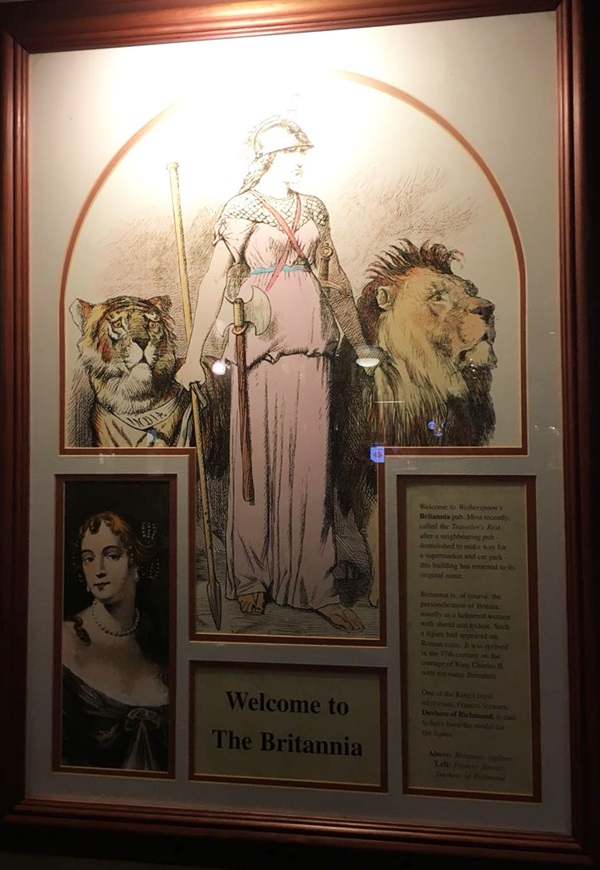
The text reads: Welcome to Wetherspoon’s Britannia pub. Most recently, called the Traveller’s Rest after a neighbouring pub – demolished to make way for a supermarket and car park – this building has returned to its original name.
Britannia is, of course, the personification of Britain, usually as a helmeted woman with shield and trident. Such a figure had appeared on Roman coins. It was revived in the 17th century on the coinage of King Charles II, with the name Britannia.
One of the King’s royal mistresses, Frances Stewart, Duchess of Richmond, is said to have been the model for the figure.
Above: Britannia vigilant
Left: Frances Stewart, Duchess of Richmond.
Prints and text about manufactures in the Black Country.
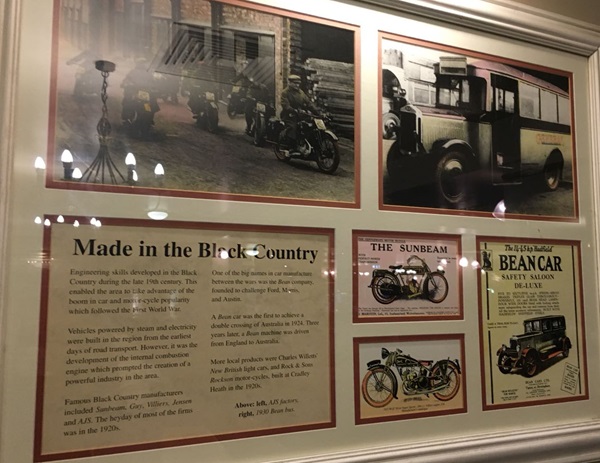
The text reads: Engineering skills developed in the Black Country during the late 19th century. This enabled the area to take advantage of the boom in car and motorcycle popularity which followed the First World War.
Vehicles powered by steam and electricity were built in the region from the earliest days of road transport. However, it was the development of the internal combustion engine which prompted the creation of a powerful industry in the area.
Famous Black Country manufacturers included Sunbeam, Guy, Villiers, Jensen and AJS. The heyday of most of the firms was in the 1920s.
One of the big names in car manufacture between the wars was the Bean company, founded to challenge Ford, Morris and Austin.
A Bean car was the first to achieve a double crossing of Australia in 1924. Three years later, a Bean machine was driven from England to Australia.
More local products were Charles Willetts’ New British light cars, and Rock & Sons Rockson motorcycles, built at Cradley Heath in the 1920s.
Above: left, AJS factory, right, 1930 Bean bus.
Illustrations and text about Rowley Regis.
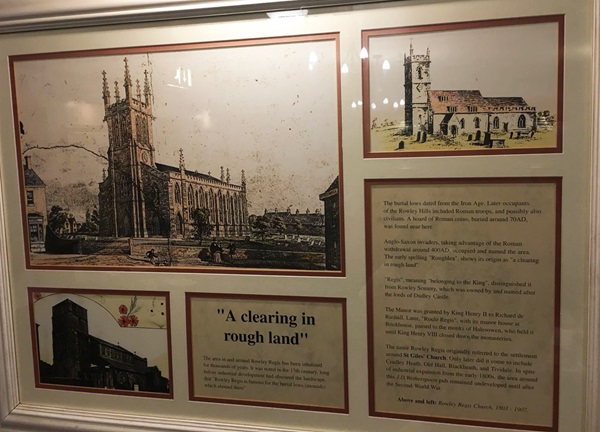
The text reads: The area in and around Rowley Regis has been inhabited for thousands of years. It was noted in the 17th century, long before industrial development had obscured the landscape that “Rowley Regis is famous for the burial lows (mounds) which abound there”.
The burial lows dated from the Iron Age. Later occupants of the Rowley Hills included Roman troops, and possibly also civilians. A hoard of Roman coins, buried around 70AD, was found near here.
Anglo-Saxon invaders taking advantage of the Roman withdrawal around 400AD, occupied and named the area. The early spelling ‘Roughlea’, shows its origin as a ‘clearing in a rough land’.
‘Regis’, meaning ‘belonging to the King’, distinguished it from Rowley Somery, which was owned by and named after the lords of Dudley Castle.
The manor was granted by King Henry II to Richard de Rushall. Later, ‘Roule Regis’, with its manor house at Brickhouse, passed to the monks of Halesowen, who held it until King Henry VIII closed down the monasteries.
The name Rowley Regis originally referred to the settlement around St Giles’ Church. Only later did it come to include Cradley Heath, Old Hall, Blackheath and Tividale. In spite of industrial expansion from the early 1800s, the area around this J D Wetherspoon pub remained undeveloped until after the Second World War.
Above and left: Rowley Regis Church, 1803-1907.
A photograph, print and text about Sir Frederick Bridge.
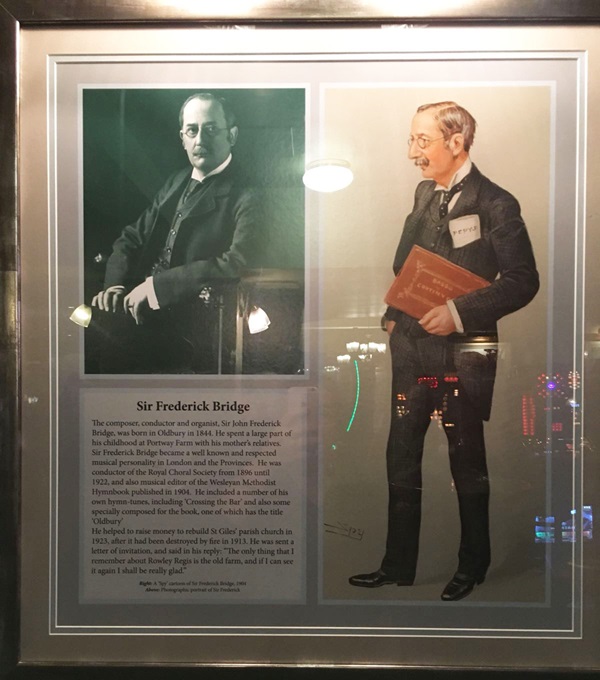
The text reads: The composer, conductor and organist, Sir John Frederick Bridge, was born in Oldbury in 1844. He spent a large part of his childhood at Portway Farm with his mother’s relatives. Sir Frederick Bridge became a well known and respected musical personality in London and the provinces. He was conductor of the Royal Choral Society from 1896 until 1922, and also musical editor of the Wesleyan Methodist Hymnbook published in 1904. He included a number of his own hymn-tunes, including Crossing the Bar and also some specially composed for the book, one of which has the title Oldbury.
He helped to raise money to rebuild St Giles’ Parish Church in 1923, after it had been destroyed by fire in 1913. He was sent a letter of invitation, and said in his reply “The only thing that I remember about Rowley Regis is the old farm, and if I can see it again I shall be really glad”.
Right: A ‘Spy’ cartoon of Sir Frederick Bridge, 1904
Above: Photograph portrait of Sir Frederick.
Illustrations and text about the Gunpowder Plot.
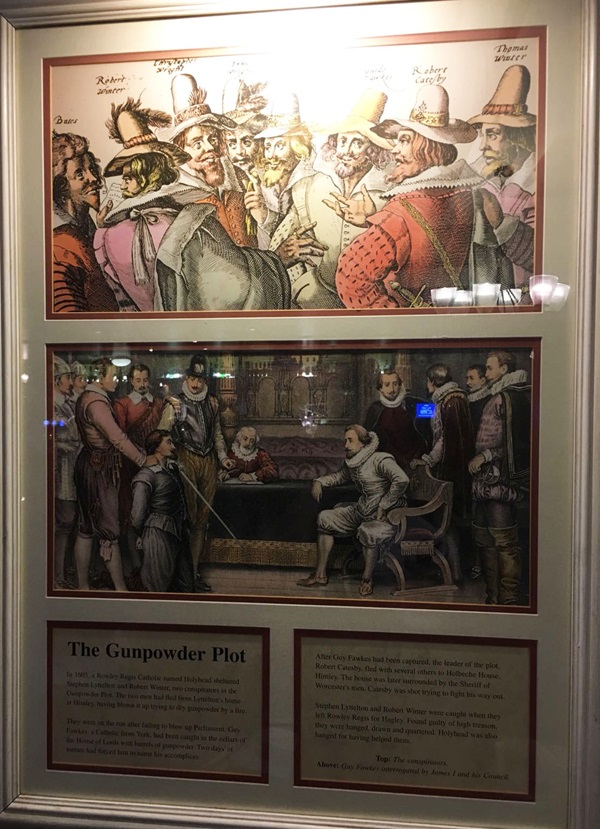
The text reads: In 1605, a Rowley Regis catholic named Holyhead sheltered Stephen Lyttlelton and Robert Winter, two conspirators in the Gunpowder Plot. The two men had fled from Lyttleton’s home at Himley, having blown it up trying to dry gunpowder by a fire.
They were on the run after failing to blow up Parliament. Guy Fawkes, a Catholic from York, had been caught in the cellars of the House of Lords with barrels of gunpowder. Two days of torture had forced him to name his accomplices.
After Guy Fawkes had been captured, the leader of the plot, Robert Catesby, fled with several others to Holbeche House, Himley. The house was later surrounded by the Sheriff of Worcester’s men. Catesby was shot trying to fight his way out.
Stephen Lyttelton and Robert Winter were caught when they left Rowley Regis for Hagley. Found guilty of high treason, they were hanged, drawn and quartered. Holyhead was also hanged for having helped them.
Top: The conspirators
Above: Guy Fawkes interrogated by James I and his council.
Photographs and text about Tommy Smart.
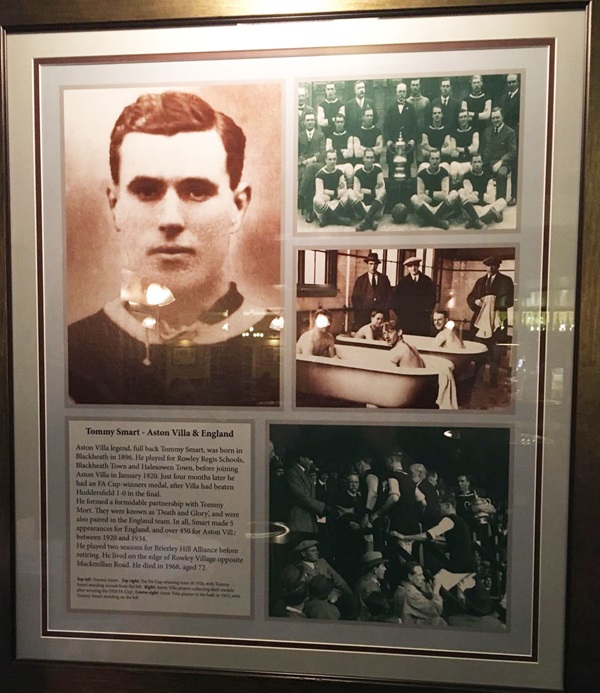
The text reads: Aston Villa legend, full back Tommy Smart, was born in Blackheath in 1896. He played for Rowley Regis Schools, Blackheath Town and Halesowen Town, before joining Aston Villa in January 1920. Just four months later he had an FA Cup winners medal, after Villa had beaten Huddersfield 1-0 in the final.
He formed a formidable partnership with Tommy Mort. They were known as ‘Death and Glory’, and were also paired in the England team. In all, Smart made 5 appearances for England, and over 450 for Aston Villa between 1920 and 1934.
He played two seasons for Brierley Hill Alliance before retiring. He lived on the edge of Rowley Village opposite Mackmillan Road. He died in 1968 aged 72.
A photograph, prints and text about Paul Shelving.
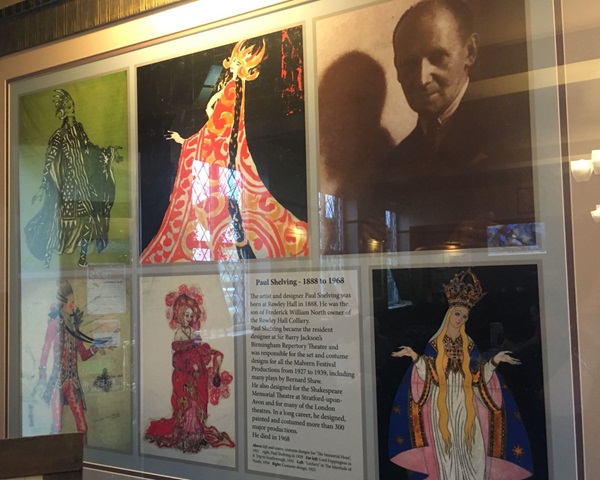
The text reads: The artist and designer Paul Shelving was born at Rowley Hall in 1888. He was the son of Frederick William North owner of the Rowley Hall Colliery.
Paul Shelving became the resident designer at Sir Barry Jackson’s Birmingham Repertory Theatre and was responsible for the set and costume designs for all the Malvern Festival Productions from 1927 to 1939, including many plays by Bernard Shaw.
He also designed for the Shakespeare Memorial Theatre at Stratford-upon-Avon and for many of the London theatres. In a long career, he designed, painted and costumed more than 300 major productions. He died in 1968.
External photograph of the building – main entrance.
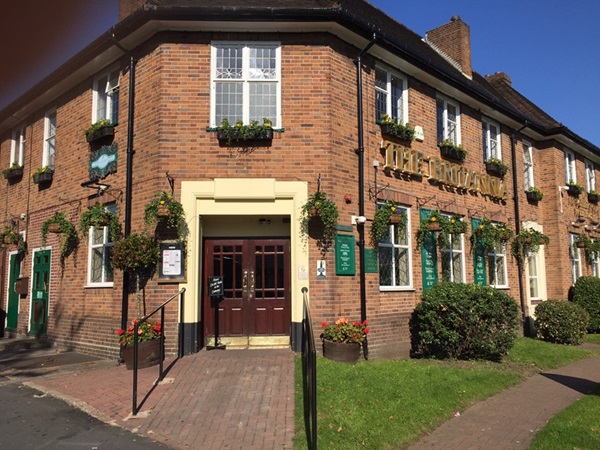
If you have information on the history of this pub, then we’d like you to share it with us. Please e-mail all information to: pubhistories@jdwetherspoon.co.uk